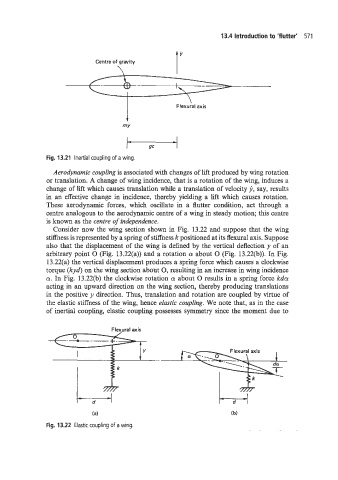Page 590 - Aircraft Stuctures for Engineering Student
P. 590
13.4 Introduction to 'flutter' 57 1
Centre of gravity
\ IY
I Flexural axis
Fig. 13.21 Inertial coupling of a wing.
Aerodynamic coupling is associated with changes of lift produced by wing rotation
or translation. A change of wing incidence, that is a rotation of the wing, induces a
change of lift which causes translation while a translation of velocity 3, say, results
in an effective change in incidence, thereby yielding a lift which causes rotation.
These aerodynamic forces, which oscillate in a flutter condition, act through a
centre analogous to the aerodynamic centre of a wing in steady motion; this centre
is known as the centre of independence.
Consider now the wing section shown in Fig. 13.22 and suppose that the wing
stiffness is represented by a spring of stiffness k positioned at its flexural axis. Suppose
also that the displacement of the wing is defined by the vertical deflection y of an
arbitrary point 0 (Fig. 13.22(a)) and a rotation a about 0 (Fig. 13.22(b)). In Fig.
13.22(a) the vertical displacement produces a spring force which causes a clockwise
torque (kyd) on the wing section about 0, resulting in an increase in wing incidence
a. In Fig. 13.22(b) the clockwise rotation a about 0 results in a spring force kda
acting in an upward direction on the wing section, thereby producing translations
in the positive y direction. Thus, translation and rotation are coupled by virtue of
the elastic stiEness of the wing, hence elastic coupling. We note that, as in the case
of inertial coupling, elastic coupling possesses symmetry since the moment due to
1-
Flexural axis
L*
(a)
Fig. 13.22 Elastic coupling of a wing.

